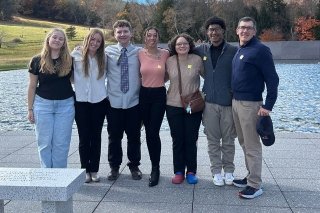Biochemistry major places first at intercollegiate convention with research presentation
Bloomsburg
Posted

Bloomsburg University student Jason Stone, a senior biochemistry major from Dresher, won first place for his oral presentation on his research at the 84th Annual Intercollegiate Chemist Convention, held virtually and hosted by Lehigh University.
Stone, who has been conducting research for several years in the lab of Matthew Polinski, associate professor of chemistry and biochemistry, was part of the (Bio)Inorganic group that also included undergraduate student presenters from Swarthmore College, Lehigh University, Ursinus College, Towson University, Messiah University, and Indiana University of Pennsylvania.
“My research experience has helped prepare me for medical school by helping and teaching me how to apply what I’ve learned in the classroom to solve problems I’ve never seen before, and in most cases, have never even thought about before,” says Stone, who already has medical school acceptances. “Research has helped me take a more analytical look at issues and taught me how to create a new plan or come up with a new idea after something didn’t work out as I intended. All this will help me in the future when I come across problems or conditions I have never seen before in order to provide the best care possible for my future patients.”
“This goes to show that BU can compete with, and even outcompete, other universities known for their undergraduate research,” says Polinski. “Undergraduate research and the use of real-world instrumentation, providing high-impact experiences, are known to increase retention and graduation rates. Our ability to provide students with such high-visibility opportunities sets us apart. These experiences are one of the key reasons chemistry and biochemistry graduates find great success in industry, graduate school, or professional school.”
Stone’s research and presentation was made possible by BU’s acquisition of both single-crystal and powder x-ray diffractometers. X-ray diffractometers enable researchers to analyze the structure and chemical bonding properties of a materials.
Earlier this year, Stone was, with Polinski and fellow student Elizabeth Docoteau, coauthor of a research paper, “Synthesis and structural characterization of an air and water stable divalent Europium squarate prepared by in situ reduction,” which appeared in the Journal of Solid State Chemistry.



